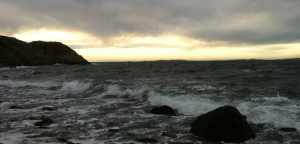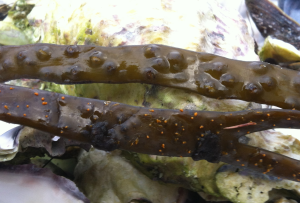
The wind was strong at Saltö, a small island on the Swedish west-coast close to the marine research station Tjärnö on January 2 when the first storm called Svea hit the shores and some of the finds were really exciting. From earlier in the year, we found a seal skeleton and a bird´s wing high up on the beach.


That it is a seal skeleton can be recognized by that the pelvis is low and sits far back. The head was not there anymore. There was not much left of the bird except for one of the wings.

Further down was a broad zone with materials washed ashore. It included lots of plastic containers in different colours, a large shovel and various species of seaweed.


Green shovel with fouling and large knotted wrack, Ascophyllum nodosum, with giant sized receptacles on the way to develop and get mature. Another sign beyond morphology of the knotted wrack, that much of the material comes from countries other than the Swedish coast, was the long rope-like receptacles of Himentalia elongata. Both males and female thalli were found among the seaweed wrack.

The picture shows the pits on the female receptacle from which oogonia and eggs are released when ripe. On the lower male receptacle the orange spots are millions of sperms released from the conceptacle. The thalli may come from the Norwegian coast which is the closest areas where this species occurs.


I also found a blue bucket, with a some green algae on the outside and many white polychaete tubes belong to the species, Pomatoceros triqueter on the inside. Upon closer scrutiny of the inside I also found two other polychaete tubes, which was lined with small pieces of shell and sand grains. Those I have not been able to determine what species it is.


The blue bucket comes right from the English Channel, which is revealed by the tiny little pink coloured barnacles. The nearest locations of this species Balanus perforates, is just there and it is also found in the Mediterranean Sea. Together with them and a small squat lobster, Munida and a small sea urchin, they have made a long journey at sea before being washed ashore on one of the beaches in Saltö, near Tjärnö where a marine biological research station is located.

The small beach beside the pier had a lot of sand washed away. It is fortunate that the root system of plants can help to retain a portion of the sand so that it does not completely disappear.


A few days earlier, it was quite cold and everything was covered with hoarfrost.
I find it strange that you only find a rubber glove and not two. So that day I found this the right glove on the beach. After the storm Svea I found the left glove on another beach, so now I have a pair.

Last night before we go home to Stockholm. A beautiful sunset at the pier at Svallhagen. All the best for the new year and hope of many new exciting discoveries and findings in 2015.




